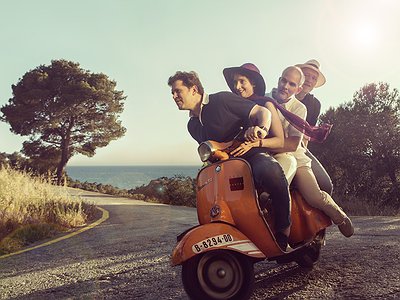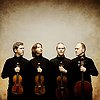Name: Cuarteto Casals
Members: Vera Martínez Mehner, Abel Tomàs Realp, Arnau Tomàs Realp, Jonathan Brown
Nationality: Spanish
Occupation: String Quartet
Musical Recommendations: Pale Fire by Vladimir Nabokov - Like playing string quartets, there is no better work to understand how subjective each of our realities actually is.
Mobiles by Alexander Calder - The ideal of a string quartet: balanced and dynamic without hierarchical implications.
If you enjoyed this interview with the Cuarteto Casals, they have an excellent web page with plenty of music, media and background information.
When did you start playing your instrument, and what or who were your early passions and influences? What is about music and/or sound that drew you to it?
Each one of us came to our instruments by a different path: Abel and Arnau began to play the piano at age 5 and then moved to the violin and cello at ages 7 and 12, respectively. Vera on the other hand began the violin at age 5, after seeing a violinist come to the house to play chamber music with her older brother, a pianist. Jonathan began with the violin at age 4, but switched to the viola at 12; being the tallest in his class, he was asked to play the viola part in chamber music groups.
However, if one were to consider the quartet as an instrument as such, Abel was 16, Vera 18 and Arnau 24 years old (Jonathan joined five years later.) Above all it was the repertory that attracted us to the string quartet - the incredible possibilities of these four instruments together, first realized by Haydn, Mozart and Beethoven.
For most artists, originality is first preceded by a phase of learning and, often, emulating others. What was this like for you? How would you describe your own development as an artist and the transition towards your own voice? What is the relationship between copying, learning and your own creativity?
As a quartet we were very fortunate to have many great teachers, each with a very clear musical vision and it has taken us many years to synthesize their perspectives with our own sensibilities; one could say that we will always be searching for our own relationship to the music we play. We certainly went through phases in which we exaggerated one or another parameter which our different teachers insisted upon: Walter Levin's fidelity to the written text, Rainer Schmidt's search for the undecorated truth in the score, Günter Pichler's insistence on the highest technical standards or György Kurtág's extraordinary sensitivity to the possibilities of every note. Perhaps one never finds a truly perfect equilibrium, but in the last years, we have found a much healthier way to balance all of these objectives and at the same time leave space for the development of our own subjective musical sensibilities.
What were some of your main artistic challenges when starting out as an artist and in which way have they changed over the years?
The principle artistic challenges for a young quartet are to survive and to create a language, verbally as well as musically, within which each member can realize his or her aspirations fully. A young quartet is a chaotic mix of influences and aspirations which need to moulded over time into a distinct and coherent voice. This process takes a great deal of time, sacrifice and patience, all of which are often in short supply in the most important years of a quartet's formation.
Tell us about your studio/work space, please. What were criteria when setting it up and how does this environment influence the creative process? How important, relatively speaking, are factors like mood, ergonomics, haptics and technology for you?
We rehearse in the basement studio at Abel's house, which has the advantages of being isolated acoustically from the neighbours and having enough space for us to not feel cramped. We have always rehearsed in relatively dry spaces, so as to hear the unvarnished truth of how we play. Once we get into a hall with a generous acoustic, it takes some time to adjust, but everything becomes much easier. The most important technology for us is decent recording equipment: we always record ourselves when learning new repertoire and find that listening back is the quickest way to solve arguments and isolate what passages actually need the most work.
Tell me about your instrument, please. What was your first instrument like and how did you progress to your current one? How would you describe the relationship with it? What are its most important qualities and how do they influence the musical results, including your own performance?
We each came to our current instruments by a different path: Vera bought her Ceruti violin in Boston; Abel commissioned his violin from David Bagué, a wonderful luthier from Barcelona; Arnau found his Corletto cello while investigating an older Italian instrument; and Jonathan's anonymous viola from the 17th Century is on loan from friends in Munich. A grant from the Borletti Buitoni Trust made possible the purchase of matching classical-period bows, which we use for Mozart, Haydn and early Beethoven, a change which greatly helps the quartet create a unique sound world for the music written in the Classical period.
Could you take us through a day in your life, from a possible morning routine through to your work? Do you have a fixed schedule? How do music and other aspects of your life feed back into each other - do you separate them or instead try to make them blend seamlessly?
Our days are very different: rehearsal days in Barcelona, teaching days, travel + concert, only concert; it is very hard to establish anything like a routine. In Barcelona we generally rehearse from 10:00-14:30, allowing for 45 minutes to sort out quartet business together and on concert days leave the morning free and rehearse in the hall two hours before the audience enters. All aspects of our life feed on each other - certainly being parents has given us a healthy perspective on our musical work - but how that process works is somewhat mysterious and hard to describe.
Could you describe your creative process on the basis of a piece or album that's particularly dear to you, please? Where did the ideas come from, how were they transformed in your mind, what did you start with and how do you refine these beginnings into the finished work of art?
The interpretive process is quite different from the creative, although there are certainly areas where they overlap. We give ourselves broad license to propose ideas and experiment with different elements of the piece until it is ready to perform. In some ways the first performance of a piece is the moment where the most enjoyable work begins: once it has a reasonably coherent form, we can start to dig deeper and refine our understanding of the composition.



